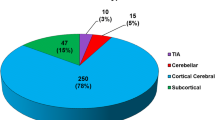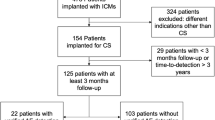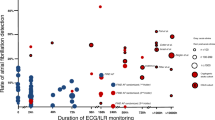Abstract
Background
The use of implantable loop recorder (ILR) to detect atrial fibrillation (AF) in patients with a history of cryptogenic stroke (CS) has seldom been investigated in “real-world” settings.
Objective
This study aimed to present the results of the Stroke Prevention by Increasing DEtection Rates of Atrial Fibrillation (SPIDER-AF) registry.
Method
SPIDER is a multicentric, observational registry, including 35 facilities all over Germany. It enrolled outpatients without AF history and with CS before ILR implantation.
Results
We included 500 patients (mean age 63.1 ± 12.7 years), 304 (60.8%) were males, with previous stroke (72.6%) and TIA (27.4%). After inclusion, all were followed for at least 12 months. AF was detected in 133 (26.8%), 25.3% of patients with previous stroke and 29.9% with TIA (p = 0.30). AF was detected after a median of 121.5 days (IQR 40.5–223.0). AF was primarily paroxysmal (95.7% after stroke, 100% after TIA). In 19.5% (n = 26) anticoagulation was not administered after AF detection. Mean CHA2DS2-VASc score (OR 1.22; CI 1.01–1.49; p = 0.037) and age > 70 years (OR 0.41; CI 0.19–0.88; p = 0.0020) correlated with AF. Repeat cerebrovascular events at follow-up (28; 5.6%) correlated with AF (OR = 2.17; CI 1.00–4.72; p = 0.049). AF (p = 0.91) and recurrent events (p = 0.43) occurred similarly in females and males.
Conclusions
In the context of cryptogenic strokes ILRs are a valuable tool for early detection of AF. In a real-world scenario, the anticoagulation therapy remains inadequate despite diagnosed AF in a relevant subset of patients requiring optimization of patient management.
Graphical abstract





Similar content being viewed by others
Data availability
Data are available and can be provided upon written request to the Service GmbH.
References
Hindricks G, Potpara T, Dagres N, Arbelo E, Bax JJ, Blomström-Lundqvist C, Boriani G, Castella M, Dan GA, Dilaveris PE, Fauchier L, Filippatos G, Kalman JM, La Meir M, Lane DA, Lebeau JP, Lettino M, Lip GYH, Pinto FJ, Thomas GN, Valgimigli M, Van Gelder IC, Van Putte BP, Watkins CL, ESC Scientific Document Group (2021) ESC guidelines for the diagnosis and management of atrial fibrillation developed in collaboration with the European Association for Cardio-Thoracic Surgery (EACTS). Eur Heart J 42(5):373–498
Hart RG, Diener HC, Coutts SB et al (2014) Embolic stroke of undetermined source: the case for a new clinical construct. Lancet Neurol 13:429–438
Foulkes MA et al (1988) The Stroke Data Bank: design, methods, and baseline characteristics. Stroke 19:547–554
Adams HP Jr, Bendixen BH, Kappele EJ et al (1993) Classification of subtype of acute ischemic stroke. Definitions for use in a multicenter clinical trial. TOAST Stroke 24:35–41
Bang OY, Lee PH, Joo SY et al (2003) Frequency of stroke recurrence after cryptogenic stroke. Ann Neurol 54:227–234
Hart RG, Sharma M, Mundl H et al (2018) NAVIGATE ESUS Investigators. Rivaroxaban for stroke prevention after embolic stroke of undetermined source. N Engl J Med 378(23):2191–2201
Diener HC, Sacco RL, Easton JD et al (2019) Dabigatran for prevention of stroke after embolic stroke of undetermined source. N Engl J Med 380:1906–1917
Brignole M, Vardas P, Hoffmann e, et al (2009) Indications for the use of diagnostic implantable and external ECG loop recorders. Europace 11:671–687
Gladstone DJ, Spring M, Dorian P et al (2014) Atrial fibrillation in patients with cryptogenic stroke. N Engl J Med 370:2467–2477
Hindricks G, Piorkowski C, Tanner H et al (2005) Perception of atrial fibrillation bevor and after radiofrequency catheter ablation: relevance of asymptomatic arrhythmia recurrence. Circulation 112:307–313
Glotzer TV, Ziegler PD (2013) Silent atrial fibrillation as a stroke risk factor and anticoagulation indication. Can J Cardiol 29:14–23
Ritter MA, Kochhauser S, Duning T et al (2013) Occult atrial fibrillation in cryptogenic stroke: detection by 7-day electrocardiogram versus implantable cardiac monitors. Stroke 44:1449–1452
Sanna T, Diener HC, Passman RS et al (2014) Cryptogenic stroke and underlying atrial fibrillation. N Engl J Med 370:2478–2486
Poli S, Diedler J, Hartig F et al (2016) Insertable cardiac monitors after cryptogenic stroke—a risk for based approach to enhance the detection rate for paroxysmal atrial fibrillation. Eur J Neurol 23:375–381
Brachmann J, Morillo CA, Sanna T et al (2016) Uncovering atrial fibrillation beyond short-term monitoring in cryptogenic stroke patients: three-year results from the cryptogenic stroke and underlying atrial fibrillation trial. Circ Arrhythm Electrophysiol 9:e003333
Häusler KG, Gröschel K, Köhrmann M et al (2018) Positionspapier zur Detektion von Vorhofflimmern nach ischämischem Schlaganfall. Aktuelle Neurol 45:93–106
Ziegler P, Rogers J, Ferreira S et al (2017) Long-term detection of atrial fibrillation with insertable cardiac monitors in a real-world cryptogenic stroke population. Int J Cardiol 244:175–179
Etgen T, Hochreiter M, Mundel M et al (2013) Insertable cardiac event recorder in detection of atrial fibrillation after cryptogenic stroke. Stroke 44:2007–2013
Afzal MR, Gunda S, Waheed S et al (2015) Role of outpatient cardiac rhythm monitoring in cryptogenic stroke: a systematic review and meta-analysis. Pacing Clin Electrophys 38:1236–1245
Dussault C, Toeg H, Nathan M et al (2015) Electrocardiografic monitoring for detecting atrial fibrillation after ischemic stroke or transient ischemic attack: systematic review and meta-analysis. Circ Arrhythm Electrophysiol 8:263–269
Sinha AM, Diener HC, Morillo CA et al (2010) Cryptogenic Stroke and underlying Atrial Fibrillation (CRYSTAL AF): design and rationale. Am Heart J 160(1):36–41
Tsivgoulis G, Katsanos A, Grory B et al (2019) Prolonged cardiac rhythm monitoring and secondary stroke prevention in patients with cryptogenic cerebral ischemia. Stroke 50:2175–2218
Kleindorfer D, Towfighi A, Chaturvedi S et al (2021) Guideline for the prevention of stroke in patients with stroke and transient ischemic attack: a guideline from the American Heart Association/American Stroke Association. Stroke 52:e364–e467
Dion F, Saudeau D, Bonnaud I et al (2010) Unexpected low prevalence of atrial fibrillation in cryptogenic ischemic stroke: a prospective study. J Interv Card Electrophysiol 28:101–107
Dahal K, Chapagain B, Maharjan R et al (2016) Prolonged cardiac monitoring to detect atrial fibrillation after cryptogenic stroke or transient ischemic attack: a meta-analysis of randomized controlled trials. Ann Noninvasive Electrocardiol 21(4):382–388
Page RL, Wilkinson WE, Clair WK et al (1994) Asymptomatic arrhythmias in patients with symptomatic paroxysmal atrial fibrillation and paroxysmal supraventricular tachycardia. Circulation 89:224–227
Glotzer TV, Daoud E, Wyse G et al (2009) The relationship between daily atrial tachyarrhythmia burden from implantable device diagnostics and stroke risk. Circ Arrhythm Electrophysiol 2:474–480
Healey JS, Connolly SJ, Gold MR et al (2012) Subclinical atrial fibrillation and the risk of stroke. N Engl J Med 366:120–129
Van Gelder IC, Healey JS, Crijns HJGM (2017) Duration of device-detected subclinical atrial fibrillation and occurrence of stroke in ASSERT. Eur Heart J 38:1339–1344
Lip GY, Nieuwlaat R, Pisters R et al (2010) Refining clinical risk stratification for predicting stroke and thromboembolism in atrial fibrillation using a novel risk factor-based approach: the Euro Heart Survey on atrial fibrillation. Chest 137:263–272
Brambatti M, Connolly SJ, Gold MR et al (2014) Temporal relationship between subclinical atrial fibrillation and embolic events. Circulation 129:2094–2099
Sposato LA, Cipriano LE, Riccio PM et al (2015) Very short paroxysm account for more than half of the cases of atrial fibrillation detected after stroke and TIA: a systematic review and meta-analysis. Int J Stroke 10:801–807
Svendsen JH, Diederichsen SZ, Hojberg S et al (2021) Implantable loop recorder detection of atrial fibrillation to prevent stroke (the LOOP study): a randomised controlled trial. Lancet 398(10310):1507–1516
Svennberg E, Friberg L, Frykman V et al (2021) Clinical outcomes in systematic screening for atrial fibrillation (STROKESTOP): a multicentre, parallel group, unmasked, randomised controlled trial. Lancet 398(10310):1498–1506
Ruff CT, Giugliano RP, Braunwald E et al (2014) Comparison of the efficacy and safety of new oral anticoagulants with Warfarin in patients with atrial fibrillation: a meta-analysis of randomised trials. Lancet 383:955–962
Haas S, Camm JA, Harald D et al (2023) GARFIELD-AF: risk profiles, treatment patterns and 2-year outcomes in patients with atrial fibrillation in Germany, Austria and Switzerland (DACH) compared to 32 countries in other regions worldwide. Clin Res Cardiol 112:759–771
Geisler T, Poli S, Meisner C et al (2017) Apixaban for treatment of embolic stroke of undetermined source (ATTICUS randomized trial): rationale and study design. Int J Stroke 12(9):985–990
Kamel H, Longstreth WT Jr, Tirschwell DL, Kronmal RA, Broderick JP, Palesch YY et al (2019) The atrial cardiopathy and antithrombotic drugs in prevention after cryptogenic stroke randomized trial: rationale and methods. Int J Stroke 14(2):207–214
Jalini S, Rajalingam R, Nisenbaum R et al (2019) Atrial cardiopathy in patients with embolic strokes of unknown source and other stroke etiologies. Neurology 92(4):e288–e294
Gladstone DJ, Dorian P, Spring M et al (2015) Atrial premature beats predict atrial fibrillation in cryptogenic stroke: results from the embrace trial. Stroke 46:936–941
Bicini Z, Intzilakis T, Nielsen OW et al (2010) Excessive supraventricular ectopic activity an increased risk of atrial fibrillation and stroke. Circulation 121:1904–1911
Virani SS, Alonso A, Benjamin EJ (2020) Heart disease and stroke statistics-2020 update: a report from the American Heart Association. Circulation 141:e139–e596
Kaplan RM, Koehler J, Ziegler PD et al (2019) Stroke risk as a function of atrial fibrillation duration and CHA2DS2-VASc-Score. Circulation 140:1639–1646
Thijs VN, Brachmann J, Morillo CA et al (2016) Predictors for atrial fibrillation detection after cryptogenic stroke: results from crystal AF. Neurology 86:261–269
Wachter R, Lahno R, Haase B et al (2012) Natriuretic peptides for the detection of paroxysmal atrial fibrillation in patients with cerebral ischemia: the FIND-AF study. PLoS ONE 7(4):e34351
Schnabel RB, Larson MG, Yamamoto JF et al (2010) Relations of biomarkers of distinct pathophysiological pathways and atrial fibrillation incidence in the community. Circulation 121:200–207
Riordan M, Opaskar A, Yoruk A et al (2020) Predictors of atrial fibrillation during long-term implantable cardiac monitoring following cryptogenic stroke. J Am Heart Assoc 9(15):e016040
Wachter R, Groschel K, Gelbrich G et al (2017) Holter-electrocardiogram-monitoring in patients with acute ischaemic stroke (Find-AF RANDOMISED): an open-label randomised controlled trial. Lancet Neurol 16(4):282–290
Haeusler KG, Kirchhof P, Kunze C et al (2021) Systematic monitoring for detection of atrial fibrillation in patients with acute ischemic stroke (MonDAFIS): a randomised, open label, multicentre study. Lancet Neurol 20(6):426–436
Rexrode KM, Madsen TE, Yu AYX et al (2022) The impact of sex and gender on stroke. Circ Res 130(4):512–528
Madsen TE, Howard VJ, Jiménez M et al (2018) Impact of conventional stroke risk factors on stroke in women: an update. Stroke 49:536–542
Kostopoulou A, Zeljko HM, Bogossian H, on the behalf of the DAS-CAM participants-2017–2018 et al (2020) Atrial fibrillation-related stroke in women: evidence and inequalities in epidemiology, mechanisms, clinical presentation, and management. Clin Cardiol 43:14–23. https://doi.org/10.1002/clc.23284
Yong JH, Thavorn K, Hoch JS et al (2016) Potential cost-effectiveness of ambulatory cardiac rhythm monitoring after cryptogenic stroke. Stroke 47:2380–2385
Diamatopoulos A, Sawyer LM, Lip GY et al (2013) Cost-effectiveness of an insertable cardiac monitor to detect atrial fibrillation in patients with cryptogenic stroke. Int J Stroke 11:302–312
Acknowledgements
The authors thank Peter Klein, mathematician at d.s.h. statistical services GmbH, Rohrbach, Germany, for the statistical input. Project management was the responsibility of Susanne Oldenburg and Simon Glück, BNK Service GmbH, Munich, Germany.
Author information
Authors and Affiliations
Consortia
Corresponding author
Ethics declarations
Conflict of interest
Medtronic and Bayer Vital GmbH have sponsored the study. KR, SG, WH, and FG have received honorary fees for conducting the study. There are no further conflicts of interest to declare.
Supplementary Information
Below is the link to the electronic supplementary material.
Rights and permissions
Springer Nature or its licensor (e.g. a society or other partner) holds exclusive rights to this article under a publishing agreement with the author(s) or other rightsholder(s); author self-archiving of the accepted manuscript version of this article is solely governed by the terms of such publishing agreement and applicable law.
About this article
Cite this article
Rybak, K., D´Ancona, G., Glück, S. et al. Detection of atrial fibrillation using an implantable loop recorder in patients with previous cryptogenic stroke: the SPIDER-AF registry (Stroke Prevention by Increasing DEtection Rates of Atrial Fibrillation). Clin Res Cardiol 112, 1848–1859 (2023). https://doi.org/10.1007/s00392-023-02283-4
Received:
Accepted:
Published:
Issue Date:
DOI: https://doi.org/10.1007/s00392-023-02283-4




